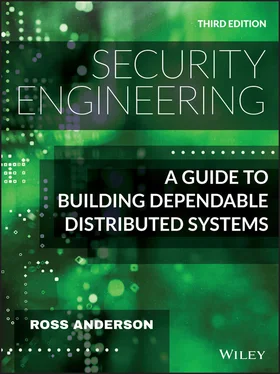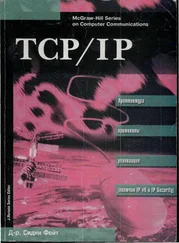Let's look at an important example of ACLs – their implementation in Unix (plus its derivatives Android, MacOS and iOS).
6.2.3 Unix operating system security
In traditional Unix systems, files are not allowed to have arbitrary access control lists, but simply rwxattributes that allow the file to be read, written and executed. The access control list as normally displayed has a flag to show whether the file is a directory, then flags r, w and x for owner, group and world respectively; it then has the owner's name and the group name. A directory with all flags set would have the ACL:
drwxrwxrwx Alice Accounts
In our first example in Figure 6.1, the ACL of file 3 would be:
-rw-r----- Alice Accounts
This records that the file is simply a file rather than a directory; that the file owner can read and write it; that group members (including Bob) can read it but not write it; that non-group members have no access at all; that the file owner is Alice; and that the group is Accounts.
The program that gets control when the machine is booted (the operating system kernel) runs as the supervisor, and has unrestricted access to the whole machine. All other programs run as users and have their access mediated by the supervisor. Access decisions are made on the basis of the userid associated with the program. However if this is zero ( root), then the access control decision is ‘yes’. So root can do what it likes – access any file, become any user, or whatever. What's more, there are certain things that only root can do, such as starting certain communication processes. The root userid is typically made available to the system administrator in systems with discretionary access control.
This means that the system administrator can do anything, so we have difficulty implementing an audit trail as a file that they cannot modify. In our example, Sam could tinker with the accounts, and have difficulty defending himself if he were falsely accused of tinkering; what's more, a hacker who managed to become the administrator could remove all evidence of his intrusion. The traditional, and still the most common, way to protect logs against root compromise is to keep them separate. In the old days that meant sending the system log to a printer in a locked room; nowadays, it means sending it to another machine, or even to a third-party service. Increasingly, it may also involve mandatory access control, as we discuss later.
Second, ACLs only contain the names of users, not of programs; so there is no straightforward way to implement access triples of (user, program, file). Instead, Unix provides an indirect method: the set-user-id ( suid) file attribute. The owner of a program can mark the file representing that program as suid, which enables it to run with the privilege of its owner rather than the privilege of the user who has invoked it. So in order to achieve the functionality needed by our second example above, we could create a user ‘ account-package’ to own file 2 (the accounts package), make the file suidand place it in a directory to which Alice has access. This special user can then be given the access that the accounts program needs.
But when you take an access control problem that has three dimensions – (user, program, data) – and implement it using two-dimensional mechanisms, the outcome is much less intuitive than triples and people are liable to make mistakes. Programmers are often lazy or facing tight deadlines; so they just make the application suid root, so it can do anything. This practice leads to some shocking security holes. The responsibility for making access control decisions is moved from the operating system environment to the application program, and most programmers are insufficiently experienced to check everything they should. (It's hard to know what to check, as the person invoking a suid rootprogram controls its environment and could manipulate this in unexpected ways.)
Third, ACLs are not very good at expressing mutable state. Suppose we want a transaction to be authorised by a manager and an accountant before it's acted on; we can either do this at the application level (say, by having queues of transactions awaiting a second signature) or by doing something fancy with suid. Managing stateful access rules is difficult; they can complicate the revocation of users who have just been fired, as it can be hard to track down the files they've opened, and stuff can get stuck.
Fourth, the Unix ACL only names one user. If a resource will be used by more than one of them, and you want to do access control at the OS level, you have a couple of options. With older systems you had to use groups; newer systems implement the Posix system of extended ACLs, which may contain any number of named user and named group entities. In theory, the ACL and suidmechanisms can often be used to achieve the desired effect. In practice, programmers are often in too much of a hurry to figure out how to do this, and security interfaces are usually way too fiddly to use. So people design their code to require much more privilege than it strictly ought to have, as that seems to be the only way to get the job done.
The next way to manage the access control matrix is to store it by rows. These are called capabilities , and in our example in Figure 6.1above, Bob's capabilities would be as in Figure 6.4here:
| User |
Operating |
Accounts |
Accounting |
Audit |
|
System |
Program |
Data |
Trail |
| Bob |
rx |
r |
r |
r |
Figure 6.4 : A capability
The strengths and weaknesses of capabilities are roughly the opposite of ACLs. Runtime security checking is more efficient, and we can delegate a right without much difficulty: Bob could create a certificate saying ‘Here is my capability and I hereby delegate to David the right to read file 4 from 9am to 1pm, signed Bob’. On the other hand, changing a file's status becomes tricky as it can be hard to find out which users have access. This can be tiresome when we have to investigate an incident or prepare evidence. In fact, scalable systems end up using de-facto capabilities internally, as instant system-wide revocation is just too expensive; in Unix, file descriptors are really capabilities, and continue to grant access for some time even after ACL permissions or even file owners change. In a distributed Unix, access may persist for the lifetime of Kerberos tickets.
Could we do away with ACLs entirely then? People built experimental machines in the 1970s that used capabilities throughout [2024]; the first commercial product was the Plessey System 250, a telephone-switch controller [1578]. The IBM AS/400 series systems brought capability-based protection to the mainstream computing market in 1988, and enjoyed some commercial success. The public key certificates used in cryptography are in effect capabilities, and became mainstream from the mid-1990s. Capabilities have started to supplement ACLs in operating systems, including more recent versions of Windows, FreeBSD and iOS, as I will describe later.
In some applications, they can be the natural way to express security policy. For example, a hospital may have access rules like ‘a nurse shall have access to all the patients who are on his or her ward, or who have been there in the last 90 days’. In early systems based on traditional ACLs, each access control decision required a reference to administrative systems to find out which nurses and which patients were on which ward, when – but this made both the HR system and the patient administration system safety-critical, which hammered reliability. Matters were fixed by giving nurses ID cards with certificates that entitle them to access the files associated with a number of wards or hospital departments [535, 536]. If you can make the trust relationships in systems mirror the trust relationships in that part of the world you're trying to automate, you should. Working with the grain can bring advantages at all levels in the stack, making things more usable, supporting safer defaults, cutting errors, reducing engineering effort and saving money too.
Читать дальше











